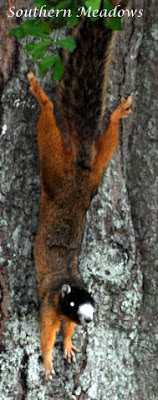Partridge Pea
Sometimes not weeding your garden has its benefits. This summer we left an area of the garden go "wild". What we discovered is that a native volunteer found its way into our garden.
This is a Partridge Pea (Chamaecrista fasciculata) sometimes known as a sensitive plant or sleeping plant. The leaves close at night and are also sensitive to the touch, hence their moniker. It is a native to the Eastern United States and grows as an annual in sun and poor soil.
If the blooms don't convince you that this wildflower is a member of the pea family (because frankly they don't resemble those blooms) then thin pea pods that show up in fall will. Game birds and song birds readily eat the seeds, hence the name Partridge Pea.
The Partridge Pea's long taproot makes it drought tolerant and also an excellent plant for erosion control; however, because of the long taproot it does not transplant well. It usually reseeds easily but since I would like to add this plant to other areas of my garden I will need to gather some seeds which is best done in mid-fall.
Four species of butterflies use this plant a a host: Orange Sulphur, Cloudless Sulphur, Gray Hairstreak and Little Yellow. All four of these are living in my region.
I found 10 of these caterpillars munching away at the leaves, pods and stalks. Once they are big and fat they will sneak off to make their chrysalis and become the Cloudless Sulphur Butterfly. Despite their bright coloring these caterpillars camouflage amazingly well on this plant, their colors blending with the bright yellow blooms and blue green foliage.
This is a Partridge Pea (Chamaecrista fasciculata) sometimes known as a sensitive plant or sleeping plant. The leaves close at night and are also sensitive to the touch, hence their moniker. It is a native to the Eastern United States and grows as an annual in sun and poor soil.
I found it flowering in July and August, attracting pollinators from bees to butterflies as well as other insects.
If the blooms don't convince you that this wildflower is a member of the pea family (because frankly they don't resemble those blooms) then thin pea pods that show up in fall will. Game birds and song birds readily eat the seeds, hence the name Partridge Pea.
The Partridge Pea's long taproot makes it drought tolerant and also an excellent plant for erosion control; however, because of the long taproot it does not transplant well. It usually reseeds easily but since I would like to add this plant to other areas of my garden I will need to gather some seeds which is best done in mid-fall.
Four species of butterflies use this plant a a host: Orange Sulphur, Cloudless Sulphur, Gray Hairstreak and Little Yellow. All four of these are living in my region.
This is the Cloudless Sulphur caterpillar which seems to like the pea pods just as well as the leaves.
I found 10 of these caterpillars munching away at the leaves, pods and stalks. Once they are big and fat they will sneak off to make their chrysalis and become the Cloudless Sulphur Butterfly. Despite their bright coloring these caterpillars camouflage amazingly well on this plant, their colors blending with the bright yellow blooms and blue green foliage.
This plant is definitely a winner with two months of blooming flowers providing nectar for the pollinators while also serving as a host plant for sulfur caterpillars plus a source of food for the birds. This beautiful native plant is moving to the front of the flower bed in my garden!






.png)
